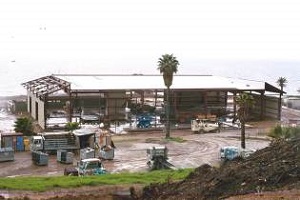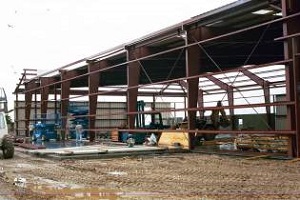Announcement
Notice Of Appeal Hearing
For UME Transportation Inc. - Eric Lopez, Vacant Lot at 19720 West Avenue B Fairmont, California 93536 APN: 3256-007-002
For Lillian Ruiz, Vacant Lot at Avenue R and In the Vicinity of 220th Street EastBlack Butte, California 93591 APN: 3084-017-033
Meeting ID: 248 896 343 433 19
Passcode: mX2Qt2za Join Virtually via MS Teams
Conference call: +1 (323) 776-6996
Conference ID: 218993663#
Updated: 2025-12-04 View Agenda >>
About Solid Waste & Related Facilities
Solid waste facilities and operations are permitted sites where nonhazardous waste generated in households, commercial establishments, institutions and light industrial wastes are collected, processed, stored or transferred. Facilities include landfills, transfer stations, and composting sites. All waste must either be reduced, reused, recycled, and/or disposed. Waste must be managed and disposed of correctly in order to control odor, litter, dust, vector and protect public health and safety and the environment. The Department of Resources Recycling and Recovery, known as CalRecycle, works in partnership with local enforcement agencies to regulate and inspect solid waste facilities. Solid waste facilities and operations that do not follow state regulations, can contaminate the land, air and water which can cause harm to public health, safety and the environment.
There are 2226 vehicles permitted with 137 active waste collectors as of January 2018.
The Solid Waste Management Program ensures that all residential, commercial, and industrial solid waste is processed, stored, transported, transferred, and disposed of in a safe, sanitary, and environmentally acceptable manner to protect public health, safety and the environment. Aside from inspecting solid waste sites, the Solid Waste Management Program also inspects illegal solid waste sites, land application complaints, waste tire generators and waste collectors servicing Los Angeles County.
The Solid Waste Management Program of the Environmental Health Division is the designated Local Enforcement Agency in Los Angeles County (except for the cities of Los Angeles, West Covina, and Vernon).
Are There Disposal Sites Where I Can Take My Trash Directly To?
On our Landfill page, you will find a list of Landfill Facilities and Transfer Stations that are open to the public. You can also visit Department of Public Works Solid Waste Information Management System (SWIMS) page to search.
How Should I Dispose of My Household Hazardous Waste?
Check with your local city to see if there are any household hazardous waste drop-off points/round-ups. Call Los Angeles County Public Works at 1-888-CLEAN-LA for scheduled household hazardous waste collection events.
For more information:
Useful Links
- Department of Public Works Solid Waste Information Management System (SWIMS)
- Clean LA
- Sanitation Districts of Los Angeles County
- South Coast Air Quality Management District (SQAQMD)
- Department of Toxic Substances Control (DTSC)
- State of California Environmental Protection Agency (Cal EPA)
- California Water Boards Los Angeles
Application
One size fits all, two page form that is filled out to formally apply for a solid waste facility permit. Owner, operator, and general features of the proposed facility must be provided.
Department of Resources Recycling and Recovery (CalRecycle)
This is the California Department of Resources Recycling and Recovery. Their offices are located at 1001 'I' Street in Sacramento. The Board, composed of six members is responsible for the enforcement of state regulations pertaining to solid waste facilities, the permitting of solid waste facilities, and the implementation of AB 939 - the recycling law. See our links page to visit their web-site.
California Environmental Quality Act (CEQA)
CEQA is the commonly used acronym for California Environmental Quality Act. Any project that is proposed to be carried out in the State of California is in some way subject to CEQA. To evaluate the environmental effects of a project, CEQA requires an impact analysis be performed. The decision process begins with an Initial Study. This study will identify impacts from the project that could potentially affect the environment, such as traffic, noise, air pollution, ground water contamination, odors, and aesthetics. If the impacts are considered major, the lead agency will prepare, or oversee the preparation of, an Environmental Impact Report. If there are impacts that can be eliminated or reduced through the incorporation of changes in the project, so-called mitigation measures, the necessity of preparing an EIR will be waived and the Lead Agency will prepare a Negative Declaration.
Conditional Use Permit
Solid waste facilities are invariably required to obtain a Conditional [Land] Use Permit, or CUP, and any significant change in an existing facility may require a revision of the CUP. The CUP is issued by the designated land use agency of the jurisdiction in which the facility will be located, and often must be approved by the local governing body during a public hearing. It will generally contain conditions that the facility must abide by.
Landfills
The trash goes in, the trash stays in. If the site has a liner, or if the site accepts what we commonly recognize as garbage. Some sites that accept only inert material are landfills, and some are not. Several types of specialized disposal sites are exempt from permitting requirements altogether.
Local Enforcement Agency (LEA)
The LEA is certified by the CalRecycle to carry out the functions of the Board on the local level. Everything the LEA does is scrutinized by the CalRecycle
Lead Agency
The Lead Agency has the responsibility, under the provisions of the California Environmental Quality Act, to conduct a thorough examination of the potential environmental effects of any project proposed to be carried out in it's jurisdiction. Typically, the Lead Agency is the first permitting authority to act on a project. Because a Conditional Use Permit is the first permit that must be obtained, the Lead Agency will usually be the local land use authority. In un-incorporated Los Angeles County this is the Department of Regional Planning. Incorporated cities designate a city department such as Planning, Zoning, Redevelopment, Public Works or Public Services.
Report of Facility Information
A document submitted to the LEA that provides the LEA with all of the information that is necessary to allow the LEA to make the determination that the facility will operate in an acceptable manner. This document provides such basics as who the owner is; how large the site is; how many square feet there are within any buildings; what the hours of operation are, etc., and also purports to demonstrate how common nuisances associated with solid waste facilities, such as odors, litter, rodent, and noise will be dealt with. Generally bound with this document are other permits (CUP, NPDES, Air Board) detailed site maps, engineering assumptions and calculations, and just about everything else that relates to the facility.
Solid Waste Facility
Defining a solid waste facility (i.e., oversight by the CalRecycle) is no longer as easy as it once was; there are many gray areas. If in the course of a day's activities, a business disposes by landfilling in excess of 10% of the material it takes in, then it is probably a solid waste facility. Assuming, of course, that the material taken in is waste materials. Used tire storage yards and composting facilities (where, theoretically, nothing is landfilled) are now solid waste facilities.
State Minimum Standards
Not leaving anything to chance, the California Legislature has attempted to set down in writing what it considers to be decent business practices. These have come to be known as State Minimum Standards. They are found in Title 14 and Title 27 of the California Code of Regulations. All facilities that are not landfills are found in Title 14. Landfill standards are found in Title 27.
Solid Waste Facility Permit (SWFP)
This is what you get from an LEA that will allow you to operate.
Tiers
Size does matter. Transfer stations, and landfills, accepting over 50 tons per day require a full permit. Smaller facilities can get by with a registration permit, a very much easier and far less time-consuming process, and some very small operations are required merely to notify the Local Enforcement Agency (LEA) of their existence. Likewise, tire storage yards and composting facilities fall into tiers, but the criteria is different.
Transfer Stations
The trash goes in, the trash goes out. The trash does not stay on-site for more than 48 hours.
Grand Central Recycling and Transfer Station Permit Receives Waste Board Seal of Approval
On February 20, 2001 the California Department of Resources and Recycling (CalRecycle) concurred in the issuance of a Solid Waste Facility Permit to City of Industry Disposal, dba Grand Central Recycling and Transfer Station, Inc., to operate a 1,500 tons per day Transfer Station in the City of Industry. The facility will be used primarily by the operator, but will be open to other commercial haulers and self-haulers. Acting for the proponent was Clements Environmental.
Pebbly Beach Landfill Permit Gets Thumbs Up
After three public hearings, and two environmental reviews, on March 21, 2001 the CalRecycle concurred in the issuance of a Solid Waste Facility Permit to Republic Industries, dba Seagull Sanitation, for the Pebbly Beach Landfill. Speaking on behalf of the site was Rob Clark, City Manager of the city of Avalon. There was no opposition. As has been reported here, the site will include a material recovery facility (MRF) and a composting operation.

The operator is being assisted by Matt Cotton of Integrated Waste Management Consulting in the composting area. The landfill will be converted to a bale-fill. Construction of the MRF is well underway. These photographs show the structure as it existed at the end of May. Since then, the exterior walls have been erected. Inside, an eight person sorting line, a baler and a shredder are in place. With a panoramic view of the Pacific Ocean and the undeveloped Island interior as a backdrop, there may not be a more beautiful location for a landfill in the entire State of California.

Informally
Republic Industries has contracted with UltraSystems Environmental Inc. to develop a CEQA analysis for the BelArt Transfer Station in Long Beach. Tentatively, the operator has indicated they will be seeking an increase in the permitted tonnage from 1,500 to 4,000 tons per day. Because of a unique land use arrangement, the LEA will be the Lead Agency for CEQA.
Environmental Science Associates has submitted a draft Report of Station Information (RSI) for the Culver City Transfer Station. The applicant (Culver City) will be seeking to revise the SWFP to essentially double the permitted tonnage from 500 to 1,056 tons per day. The City of Culver City is the Lead Agency for CEQA and is in the process of developing the Initial Study.
Report a Problem
If you have questions or concerns about solid waste and other related facilities contact the Solid Waste Inspection and Enforcement Program at (626) 430-5540. To report other public health issues, call the Environmental Health Call Center at (888) 700-9995 or file a complaint online.




